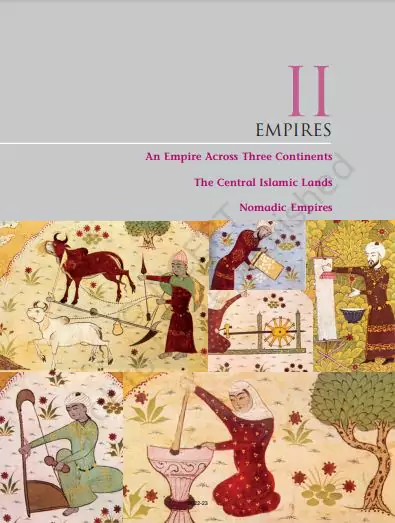‘NCERT Solutions for Class 11 History Chapter 3 An Empire Across Three Continents’ PDF Quick download link is given at the bottom of this article. You can see the PDF demo, size of the PDF, page numbers, and direct download Free PDF of ‘Ncert Class 11 History Chapter 3 Exercise Solution’ using the download button.
An Empire Across Three Continents Textbook With Solution PDF Free Download

Chapter 3: An Empire Across Three Continents
OVER the two millennia that followed the establishmentO of empires in Mesopotamia, various attempts at empirebuilding took place across the region and in the area to the west and east of it.
By the sixth century BCE, Iranians had established control over major parts of the Assyrian empire. Networks of trade developed overland, as well as along the coasts of the Mediterranean Sea.
In the eastern Mediterranean, Greek cities and their colonies benefited from improvements in trade that were the result of these changes.
They also benefited from close trade with nomadic people to the north of the Black Sea. In Greece, for the most part, city-states such as Athens and Sparta were the focus of civic life.
From among the Greek states, in the late fourth century BCE, the ruler of the kingdom of Macedon, Alexander, undertook a series of military campaigns and conquered parts of North Africa, West Asia and Iran, reaching up to the Beas.
Here, his soldiers refused to proceed further east. Alexander’s troops retreated, though many Greeks stayed behind.
Throughout the area under Alexander’s control, ideals and cultural traditions were shared amongst the Greeks and the local population. The region on the whole became ‘Hellenised’ (the Greeks were called Hellenes), and Greek became a well-known language throughout.
The political unity of Alexander’s empire disintegrated quickly after his death, but for almost three centuries after, Hellenistic culture remained important in the area.
The period is often referred to as the ‘Hellenistic period’ in the history of the region, but this ignores the way in which other cultures (especially Iranian culture associated with the old empire of Iran) were as important as – if not often more important than – Hellenistic notions and ideas.
This section deals with important aspects of what happened after this.
Small but well-organised military forces of the central Italian citystate of Rome took advantage of the political discord that followed the disintegration of Alexander’s empire and established control over North Africa and the eastern Mediterranean from the second century BCE. At the time, Rome was a republic.
Government was based on a complex system of election, but its political institutions gave some importance to birth and wealth and society benefited from slavery.
The forces of Rome established a network for trade between the states that had once been part of Alexander’s empire. In the middle of the first century BCE, under Julius Caesar, a high-born military commander, this ‘Roman Empire’ was extended to present-day Britain and Germany.
Latin (spoken in Rome) was the main language of the empire, though many in the east continued to use Greek, and the Romans had a great respect for Hellenic culture.
There were changes in the political structure of the empire from the late first century BCE, and it was substantially Christianised after the emperor Constantine became a Christian in the fourth century CE.
To make government easier, the Roman Empire was divided into eastern and western halves in the fourth century CE.
But in the west, there was a breakdown of the arrangements that existed between Rome and the tribes in frontier areas (Goths, Visigoths, Vandals and others).
| Author | NCERT |
| Language | English |
| No. of Pages | 28 |
| PDF Size | 5.3 MB |
| Category | History |
| Source/Credits | ncert.nic.in |
NCERT Solutions Class 11 History Chapter 3 An Empire Across Three Continents
Question 1.
If you had lived in the Roman Empire, where would you rather have lived—in the towns or in the countryside? Explain why?
Answer:
I would have liked to live in towns of the Roman empire as it had better sources of earning and facility to fight with natural calamities that occurred frequently.
In Roman city, there was such a structure which was quite strong to fight with the daily lives problems. Because towns were coming under the territory of city and they had been aided by the people who belonged to the political and business related fields.
Question 2.
Compile a list of some of the towns, cities, rivers, seas and provinces mentioned in this chapter, and then try and find them on the maps. Can you say something about any three of the items in the list you have compiled?
Answer:
Continents: Europe, North Africa.
Island: Sicily
Rivers: Nile, Rhine, Danube, Sind
Sea: Mediterranean, Caspian, Black sea, Aegean sea.
Provinces: Gaul, Numidia, Tunisia, Macedonia, etc.
Towns and Cities: Constantinople, Naples, Damascus, Alexandria and Rome. (See NCERT Page 59)
Description of three items compiled in the list:
- Rivers helped in providing irrigation facilities for agriculture.
- Seas and oceans helped in the promotion of trade and commerce.
- Towns and cities were the main centers of economic, social and political activities of the empire.
Question 3.
Imagine that you are a Roman housewife preparing a shopping list for household requirements. What would be on the list?
Answer:
As a Roman housewife, I would like to include the following items in my list, while preparing a shopping list for household requirements-Roman glass painting, curtains, kitchen appliances, bed sheet, cushion cover, toys, furniture and other modem appliances of daily life.
NCERT Class 11 History Textbook Chapter 3 An Empire Across Three Continents With Answer PDF Free Download
